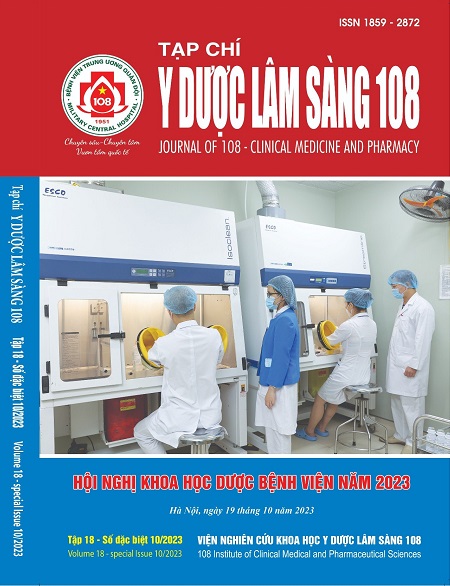Survey on practical use of colistin on patients at the Intensive Care Unit, 175 Military Hospital
Main Article Content
Keywords
Abstract
Objective: To survey the practical use of colistin at the Intensive Care Unit (ICU), 175 Military Hospital and its unwanted effects on kidneys. Subject and method: A retrospective descriptive study based on information collected from case records of 124 patients with colistin use at the ICU, 175 Military Hospital from January 1st, 2022 to December 31st, 2022. Result: Median age was 63.5 years (49-72). 92.7% of patients infected with multiple drug resistant (MDR) bacteria. Median dose of colistin was 8 (8-10) MIU/day, median duration of treatment was 9.5 (6-12) days. The most common antibiotics used in combination with colistin were carbapenem, tetracycline and aminoglycoside. 42.7% of patients had nephrotoxicity. Factors associated with colistin-related nephrotoxicity included: Chronic kidney disease, ≥ 2 MDR bacteria, infection with K. pneumoniae or P. aeruginosa, duration of hospital stay, concomitant use of furosemide or amikacin, basal SCr and duration of colistin use. Conclusion: The high incidence of acute kidney impairment suggested the nescessity of close monitoring the use of colistin in clinical practice.
Article Details
References
2. Kluytmans J (2017) Plasmid-encoded colistin resistance: mcr-one, two, three and counting. Euro Surveill 22(31).
3. Ouslander J et al (2009) Hazzard's geriatric medicine & gerontology. McGraw-Hill Companies, Incorporated.
4. Binh NG, Hayakawa K, Co DX, Tuan ND, Anh NH, Thuy NT, Phuong DM, Huong NT, Thuy PT, Chau NQ, Nhung PH, Gam do TH, Hai DT, Huong TT, Van Anh L, Takeshita N, Ohmagari N (2015) The efficacy and nephrotoxicity associated with colistin use in an intensive care unit in Vietnam: Use of colistin in a population of lower body weight. Int J Infect Dis 35: 18-23.
5. Đào Xuân Cơ, D.T.H., Nguyễn Hoàng Anh (2016) Phân tích hiệu quả và độc tính trên thận của chế độ liều cao colistin trên bệnh nhân nhiễm trùng bệnh viện tại Khoa Hồi sức tích cực, Bệnh viện Bạch Mai. Tạp chí Y học Việt Nam 41, tr. 36-43.
6. Antonelli A, Coppi M, Tellapragada C, Hasan B, Maruri A, Gijón D, Morecchiato F, de Vogel C, Verbon A, van Wamel W, Kragh KN, Frimodt-Møller N, Cantón R, Giske CG, Rossolini GM (2022) Isothermal microcalorimetry vs checkerboard assay to evaluate in-vitro synergism of meropenem-amikacin and meropenem-colistin combinations against multi-drug-resistant Gram-negative pathogens. Int J Antimicrob Agents 60(4): 106668.
7. Dickstein Y, Leibovici L, Yahav D, Eliakim-Raz N, Daikos GL, Skiada A, Antoniadou A, Carmeli Y, Nutman A, Levi I, Adler A, Durante-Mangoni E, Andini R, Cavezza G, Mouton JW, Wijma RA, Theuretzbacher U, Friberg LE, Kristoffersson AN, Zusman O, Koppel F, Dishon Benattar Y, Altunin S, Paul M; AIDA consortium (2016) Multicentre open-label randomised controlled trial to compare colistin alone with colistin plus meropenem for the treatment of severe infections caused by carbapenem-resistant Gram-negative infections (AIDA): A study protocol. BMJ Open 6(4): 009956.
8. Bộ Y tế (2015) Dược thư quốc gia Việt Nam. Nhà xuất bản Khoa học và Kỹ thuật Hà Nội.
 ISSN: 1859 - 2872
ISSN: 1859 - 2872
